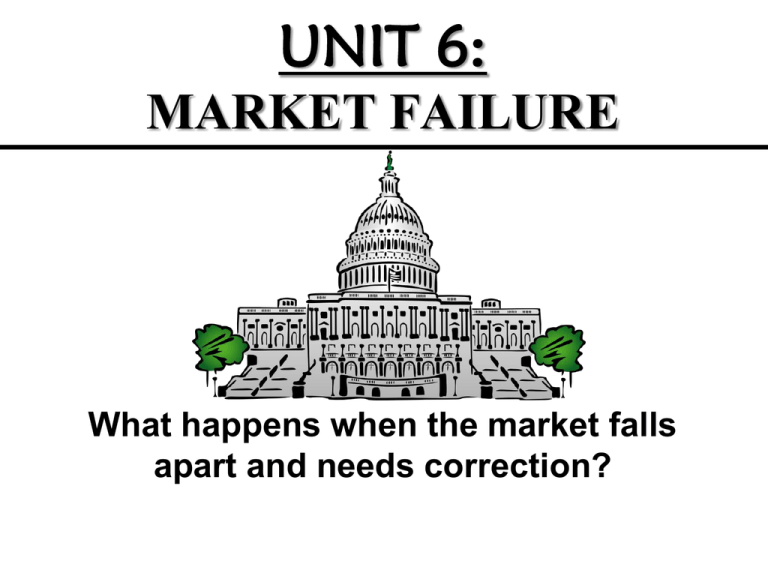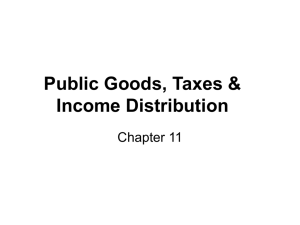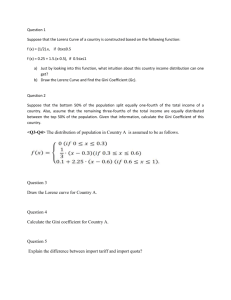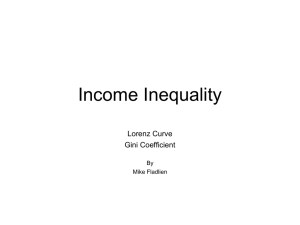Unit 6 Market Failures and Externalities
advertisement

UNIT 6: MARKET FAILURE What happens when the market falls apart and needs correction? In this section we will examine: 1. Define types of market failures 2. Marginal Social Benefit vs Marginal Social Cost 3. Marginal Private Benefit vs Marginal Private Cost 4. Define & graph externalities from market activities and resulting government corrections 5. Define socially optimum vs. private-market equilibrium 6. Income Equality: Measuring income distribution Types of Market Failure Types of Market Failure: There are plenty of reasons why the normal operation of market forces may not lead to economic efficiency. 1. Externalities: are untended consequences of the free market (could be positive – spill over benefits or negative – spill over costs) Examples: Social costs for producing cigarettes, social benefits of providing a flu shot, social cost of producing cars, social benefit of the outcome on society when offering nationalize healthcare. Types of Market Failure Types of Market Failure: There are plenty of reasons why the normal operation of market forces may not lead to economic efficiency. 2. Public Goods: are not provided by the free market because of their two main characteristics: 1. Non-excludability: where it is not possible to provide a good or service to one person without it thereby being available for others to enjoy 2. Non-rivalry: where the consumption of a good or service by one person will not prevent others from enjoying it Examples: Street lighting / lighthouse, fireworks, police services, air defense systems, roads, etc. Free-rider Problem: everyone waits until someone pays for the good, then they can use it freely. Consequently, the good is never made. Types of Market Failure Types of Market Failure: There are plenty of reasons why the normal operation of market forces may not lead to economic efficiency. 2. Asymetric Information: there is an imbalance of information between buyer and seller. Example: dentist sells extra services that are not really needed by the buyer, however the buyer gives in to seller’s superior knowledge Example: expert antique dealer enters into an antique shop and negotiates a low price for a very valuable antique due to the fact of his superior knowledge of the product compared to that of the seller. Solution: government will enforce symmetric information between buyer and seller. Types of Market Failure Types of Market Failure: There are plenty of reasons why the normal operation of market forces may not lead to economic efficiency. 3. Monopolies: government intervention to correct monopoly/oligopoly behavior (enforcing social optimal or fair-return pricing) Examples: Control of TVA, Windfall Tax (charged to certain industries when economic conditions allow those industries to experience above-average profits) Price Ceilings in apartment rental market Types of Market Failure Types of Market Failure: There are plenty of reasons why the normal operation of market forces may not lead to economic efficiency. 4. Unstable Prices: government intervention to correct varying price (usually in commodity markets. Examples: Gas prices in 1970s, Rent Controls in New York Types of Market Failure Types of Market Failure: 5. There are plenty of reasons why the normal operation of market forces may not lead to economic efficiency. Income Inequality: government intervention to lessen the gap between income groups Lorenz Curve shows the income distribution of a county Example: Progressive Taxation, minimum wage, welfare The Lorenz curve can be used to show what percentage of a nation's residents possess what percentage of that nation's income. For example, it might show that the country's poorest 10% possess only 2% of the country's wealth. Market Failure: Vocabulary Marginal private benefit (MPB) is the extra benefit to a firm from producing an extra unit of its product. This is the price the firm receives from selling the extra unit. Marginal private cost (MPC) is the extra cost to the firm of producing an extra unit of output. Marginal social benefit (MSB) is the extra benefit to society from the firm making an extra unit of output. MSB shows the highest price consumers are willing to pay for a unit of the good. MSC includes the firm’s marginal private benefits plus any other spill over benefits (positive externalities) to other members of society. Marginal social cost (MSC) is the true cost to society of a firm making an extra unit of output. MSC includes the firm’s marginal private costs plus any other spill over costs (negative externalities) to other members of society. GRAPHING EXTERNALITITES Negative Externality: Detailed Example Negative Externalities (spill over costs: untended (-) outcomes) The Putrid Paper Company is located on the Cherokee River above the Clean Chemical Company. Neither firm pollutes the river at the moment: each firm takes in clean water from the Cherokee, creates dirty waste water as it makes its product, but then at its own expense cleans that dirty water before returning clean water to the river. Negative Externality: Detailed Example Negative Externalities (untended (-) outcomes) The Putrid Paper Company is located on the Cherokee River above the Clean Chemical Company. Neither firm pollutes the river at the moment: each firm takes in clean water from the Cherokee, creates dirty waste water as it makes its product, but then at its own expense cleans that dirty water before returning clean water to the river. Negative Externality: Detailed Example Supply curve S0 in each graph represents a firm’s supply curve when there is no pollution. Based on the demand for each product, the equilibrium price and quantity (in the absence of pollution) are $8 and 700 units in the paper market and $19 and 280 units in the chemical market. Negative Externality: Detailed Example Assume now that the Putrid Paper Company decides to stop cleaning its waste water and dumps dirty water into the Cherokee. It does this to reduce its production costs and increase its total profit. By reducing its costs, the firm’s supply curve shifts to the right to S1. Its equilibrium price drops to $6 and its equilibrium quantity increases to 800 units. Negative Externality: Detailed Example These changes look like good ones – consumers can buy paper at a lower price so they buy more paper. To see the undesired effects of the pollution we look downriver at its effect on the chemical market. The pollution increases Clean Chemical’s cost of making its product since it now must clean the river water before using it. This increase in costs shifts its supply curve to the left to S1. The price of chemicals rises to $22 and the number of units sold drops to 260. Tax Correction for Negative Externality Results from a tax levied to correct a negative externality Putrid Paper Company Socially Optimal quantity of pollution This is the government’s answer to pollution. Amount of market correction due to tax MPrivateC Area of correction needed. Guess what this is? DEAD WEIGHT LOSS Pre-market-corrected quantity of pollution Positive Externality Positive Externalities (spill over benefits: untended (+) outcomes) FLU SHOTS Cost / Benefit to Society S = MSC Problem DWL Too few shots offered by Free Market (FM) AMC Amount of subsidy Solution Provide incentive for societal consumption (close the DWL and fill in the Area of Market Correction AMC) D = MSB D = MPB QFM QSO Amount of under-allocation Income Inequality: Lorenz & Gini Income Inequality: government intervention to lessen the gap between income groups Lorenz Curve shows the wealth distribution of a county The Gini Coefficient is a measurement of the income distribution of a country's residents. Income Inequality: Lorenz & Gini The Gini Coefficient is the ratio of the area between the income distribution curve (Lorenz) and the line of equal distribution. Gini ranges from 0 to 1, with 1 being the most unequal distribution of wealth (one person owns everything) and 0 being the most equal (each person owns an equal share) Comparing this area to… …this area. Practice: Lorenz & Gini Family Income Distribution: U.S. 1983 Income Category Share of Total Income (%) p = Cumulative Share of Population (%) L = Cumulative Share of Income (%) Top 20% 42.7 100 100.0 4th 20% 24.4 80 57.3 3rd 20% 17.1 60 32.9 2nd 20% 11.1 40 15.8 Lowest 20% 4.7 20 4.7 Total 100 Can One Measure Inequality? YES Gini = Area A/(Area A + Area B) Practice: Lorenz & Gini Gini = Area A/(Area A + Area B) Area A + Area B 100*100/2 = Area 1 20*4.7/2 = Area 2 20*(4.7+15.8)/2 = Area 3 20*(15.8+32.9)/2 = Area 4 20*(32.9+57.3)/2 = Area 5 20*(57.3+100)/2 = Total Area B Area A 5000 - 3214 = Gini Coefficient 1786/5000 = Practice: Lorenz & Gini Gini = 36% thus income distribution is relatively equal Area A + Area B 100*100/2 = Area 1 20*4.7/2 = 47 Area 2 20*(4.7+15.8)/2 = 205 Area 3 20*(15.8+32.9)/2 = 487 Area 4 20*(32.9+57.3)/2 = 902 Area 5 20*(57.3+100)/2 = 1573 Total Area B Area A 5000 - 3214 = Gini Coefficient 1786/5000 = 5000 3214 1786 0.36 or 36% FRQ Practice







